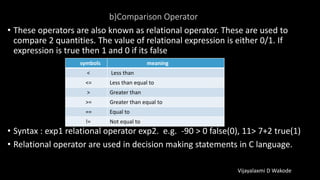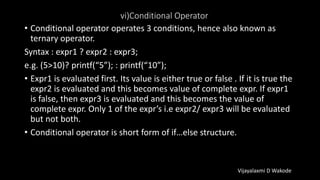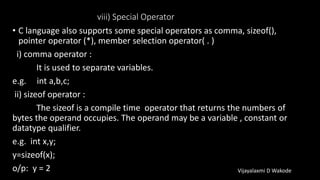fundamentals of c
- 1. 1.1 History of C Language Language Name Year of development Description ALGOL 60 1960 TOO ABSTRACT AND TOO SHORT CPL 1963 COMBINED P.L BCPL 1967 USED TO WRITE SYSTEM S/W. WAS NOT SO POWERFUL. B 1970 MACHINE DEPENDENT C 1972 GENERAL PURPOSE,COMPILED, STRUCTURED P.L, WITH UNIX O.S - ‘C’ LANGUAGE WAS DEVELOPED BY ‘DENNIS RITCHIE’ AT AT &T BELL LABORATORY IN 1972. Vijayalaxmi D Wakode
- 2. Importance of C 1. It is robust language whose rich set of built in functions and operators can be used to write any complex program. 2. The language is very well suited from writing both system s/w and business package. We can also write compilers . 3. We can also write structural programs using C language. Character Set of C LETTERS A-Z, a-z DIGITS 0-9 SPECIAL CHARACTER _ ,! , etc. WHITE SPACES tab , enter , etc. The white spaces are ignored by compiler unless they are part of strings. Vijayalaxmi D Wakode
- 3. 1.2 TOKENS IN C • To form a program i.e. set of executable statement , we need grammar. Like all language , C language also has its own rules and grammar known as syntactic rules / syntax. • The smallest individual unit in a program is known as ‘Token’. e.g. int, char, float, do , etc Num , hello, world, etc e.g. 10,5, 90.11, etc e.g. + , - , * , %,/, etc e.g. “Hello This is 1st lecture” e.g. {},[], etc Vijayalaxmi D Wakode
- 4. i) Keywords • A keyword is a reserved word whose meaning can’t be changed by user. • Keyword serves as a basic building block for program design and development. The keywords must be written in ‘Lower Case’ , they have predefined meaning . • The C language consists of 32 keywords. Table 1.1 Keywords in ANSI C Vijayalaxmi D Wakode
- 5. ii)Identifier • The words other than the keywords that are used in C program are known as ‘Identifiers’. These are the names that can be given to various program elements as variable, function, etc. • Identifier is user defined name. • The language identifies only 1st 32 characters as the identifiers. Naming rules for identifier a) First letter of identifier should not start with a digit b) Upper case and lower case letters are different c) The keyword name can’t be identifier d) White spaces and special symbols except underscore( _ ) are not allowed Vijayalaxmi D Wakode
- 6. iii) Constants • In C language , the constants are referred to fixed values that don’t change during program execution. Figure 1.1: Types of constants in C Vijayalaxmi D Wakode
- 7. a)Integer Constants • Decimal Integers : consists of a set of digits 0 to 9 preceded by an optional + or – sign. Spaces, commas and non digit characters are not permitted between digits. e.g. 12, -44 , 787878 • Octal Integers : consists of any combination of digits from 0 to 7 with prefix O. e.g. O26, O22 , O7 • Hexadecimal Integers : it is preceded by OX or Ox, they may contain alphabets from A to F(10-15) or a to f(10-15) • The quantities that are represented by numbers containing fractional parts are called real or floating point constants. These quantities are represented by numbers containing fractional parts like 98.72. e.g. 0.0023, -9.8 b)Real Constants Vijayalaxmi D Wakode
- 8. c) single character constants • These constants are of a single character may be an alphabet, digit or special symbol that is enclosed in a pairs of single quotation marks . e.g. ‘x’ , ‘12’ , ‘ . ’ , etc. • These consists of the sequence of characters that are enclosed within a pairs of a double quotation marks. e.g. “Introduction of C” , “XYZ 123 ” , etc. • In C , every string is terminated by ‘0’ . It is null character that is automatically added to the string by the compiler . It is backslash character constant. These are also known as escape sequence character . d) string character constants Vijayalaxmi D Wakode
- 9. Escape sequence characters • Backslash used in front of these characters tells the compiler to escape from regular behavior and perform the desired function. • List of the other such characters is as shown n new line b backspace t horizontal space o null character r carriage return • The constants can be defined in 2 ways in program. -we can give a direct value that is used as constant. E.g. int a=10. -we can use #define preprocessor directive. E.g. #define PI 3.14 Vijayalaxmi D Wakode
- 10. iv)Operator • A operator is defined as a symbol that tells the computer to perform certain mathematical or logical manipulation. • These are basically used to manipulate data . • C provides a rich set of built in operators. Vijayalaxmi D Wakode
- 11. a) Arithmetic Operator • The C language supports various different arithmetic operators as +,-,/,*,%. The % is known as modulus operator used to find remainder of an expression. Integer Arithmetic • An arithmetic operation performed on 2 whole numbers/ integers . It always gives an integer result. In integer division the fractional part is truncated. Floating point Arithmetic • An arithmetic operation performed on 2 real / fractional numbers. It results can be truncated according to the properties requirement. The remainder operator (%) is not applicable for floating point arithmetic operands. Mixed mode Arithmetic • An arithmetic operation performed on 1 of real operands and another integer operand. Its result is always real. Vijayalaxmi D Wakode
- 12. b)Comparison Operator • These operators are also known as relational operator. These are used to compare 2 quantities. The value of relational expression is either 0/1. If expression is true then 1 and 0 if its false • Syntax : exp1 relational operator exp2. e.g. -90 > 0 false(0), 11> 7+2 true(1) • Relational operator are used in decision making statements in C language. symbols meaning < Less than <= Less than equal to > Greater than >= Greater than equal to == Equal to != Not equal to Vijayalaxmi D Wakode
- 13. c) Logical Operator • The language supports 3 kinds of logical operator. These are basically used when we want to use more than 1 condition and make certain decision. i)Logical AND (&&) ii)Logical OR(||) iii) Logical NOT(!) A B o/p : A && B 0 0 0 0 1 0 1 0 0 1 1 1 A B o/p : A|| B 0 0 0 0 1 1 1 0 1 1 1 1 A o/p: !A 0 1 1 0 Vijayalaxmi D Wakode
- 14. v) Assignment Operator • These are used to assign the result of an expression to a variable / it can also be used to assign value to a variable. • In case of assignment operator L.H.S must be a variable but R.H.S can be expression or any constant value. e.g. A = 2, x = A + 3 • C language also supports set of short hand assignment operator . Operator Stmt with simple assign operator Stmt with shorthand property += a=a+1 a+=1 -= a=a-1 a-=1 *= a=a*1 a*=1 /= a=a/1 a/=1 %= a=a%1 a%=1 Vijayalaxmi D Wakode
- 15. v) Unary Operator Vijayalaxmi D Wakode
- 16. vi)Conditional Operator • Conditional operator operates 3 conditions, hence also known as ternary operator. Syntax : expr1 ? expr2 : expr3; e.g. (5>10)? printf(“5”); : printf(“10”); • Expr1 is evaluated first. Its value is either true or false . If it is true the expr2 is evaluated and this becomes value of complete expr. If expr1 is false, then expr3 is evaluated and this becomes the value of complete expr. Only 1 of the expr’s i.e expr2/ expr3 will be evaluated but not both. • Conditional operator is short form of if…else structure. Vijayalaxmi D Wakode
- 17. vii)Bitwise Operator • C language also supports various bitwise operator that operates at bit level. These are used to test bits them in left / right. • The o/p of bitwise AND is 1 if all the corresponding bits of all operands is 1. • The o/p of bitwise OR is 1 if at least one corresponding bits of all operands is 1. • The o/p of bitwise XOR is 1 if the corresponding bits of 2 operands are opposite. • Bitwise complement operator is an unary operator. It changes 1 to 0(condition). operator meaning & Bitwise and | Bitwise or ~ Complement ^ Bitwise exclusive or << Shift left >> Shift right Vijayalaxmi D Wakode
- 18. viii) Special Operator • C language also supports some special operators as comma, sizeof(), pointer operator (*), member selection operator( . ) i) comma operator : It is used to separate variables. e.g. int a,b,c; ii) sizeof operator : The sizeof is a compile time operator that returns the numbers of bytes the operand occupies. The operand may be a variable , constant or datatype qualifier. e.g. int x,y; y=sizeof(x); o/p: y = 2 Vijayalaxmi D Wakode
- 19. 1.3 Data Types in C • Datatype means type of data which we are going to give to computer for processing. It basically used to calculate the memory requirement. fig. 1.2. Data types in C Vijayalaxmi D Wakode
- 20. Primary Data Types These are the built in and fundamental data types . Integers are whole numbers i.e. numbers without decimal point. All these data types short int, int, long int have signed & unsigned forms. Unsigned numbers are always positive. Floating point numbers are real numbers. It has 6 digits of precision. These numbers are denoted by keyword float. When accuracy of floating point number is insufficient , we use double keyword, it has 14 digits precision. To extend precision further , we use long double. It is used to specify type of function. When function does not return any value and if there is empty parameter list It is declared using keyword char. It stores single character item. Integer Type Vijayalaxmi D Wakode Floating Point Type Void Type Character Type
- 21. Storage space requirement Type Size Range short int 8 bits(1 byte) -128 to 127 int or signed int 16 bits(2 bytes) -32768 to 32767 Unsigned int 16 bits(2 bytes) 0 to 65535 Long int 32 bits(4 bytes) -2,147,483,648 to 2,147,483,648 Unsigned long int 32 bits(4 bytes) 0 to 4,294,967,295 Float 32 bits(4 bytes) 2^32 Double 64 bits(8 bytes) 2^64 Long double 80 bits(10 bytes) 2^80 Char 8 bits(1 byte) -128 to 127 Vijayalaxmi D Wakode Table 1.2 Primary data types in C
- 22. 1.4 Variables in C • A variable is used to store data. It tells compiler variable name and data type of variable. Declaration : datatype identifier; e.g. int x,y,z; Converting lower type to higher type and vice versa, is known as type conversion. Lower type is automatically converted into higher type It is the process of local conversion. Its also known as type casting Syntax : (type name) expression; Type name is standard data type in c Vijayalaxmi D Wakode Type Conversion a) Implicit Conversion b)Explicit Conversion
- 23. 1.5 Input and Output in C Vijayalaxmi D Wakode fig.1.3 input/output function in C
- 24. Format specifiers symbol use %d integer %f Float value %c Character value %s String value %u Unsigned integer value %ld Long int Vijayalaxmi D Wakode
- 25. 1.6 Structure of C Program Documentation Section Link Section Definition Section Global Declaration Section Main() { Declaration Part; Executable Part; } Subprogram Section : Function 1, Function 2, Function 3 Vijayalaxmi D Wakode



![1.2 TOKENS IN C
• To form a program i.e. set of executable statement , we need grammar.
Like all language , C language also has its own rules and grammar known
as syntactic rules / syntax.
• The smallest individual unit in a program is known as ‘Token’.
e.g. int,
char, float,
do , etc
Num , hello,
world, etc
e.g.
10,5, 90.11,
etc
e.g.
+ , - , * , %,/,
etc
e.g. “Hello
This is 1st
lecture”
e.g.
{},[], etc
Vijayalaxmi D Wakode](https://image.slidesharecdn.com/1-170219115110/85/fundamentals-of-c-3-320.jpg)





















